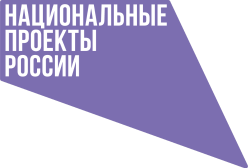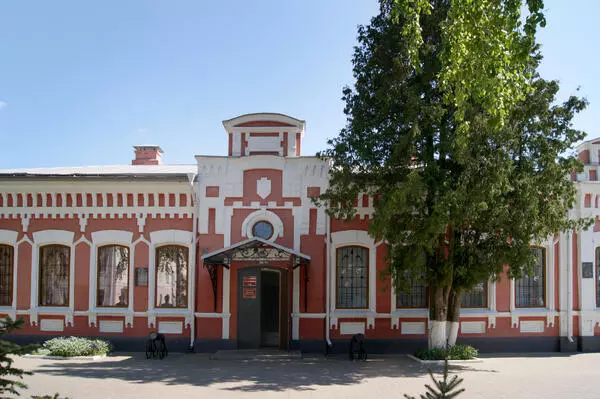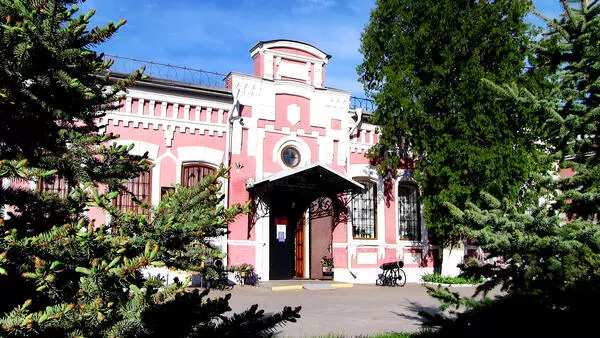The first person to systematize historical information about the Borisovka area was Ivan Grigoryevich Volkov, the author of the notes “Historical Data of the Distant Past of Our Area” (the first quarter of the 20th century). He was assisted by his niece, a student of history, Kapitalina Dmitrievna Skorbach, who collected extracts from documents kept in libraries of large cities.
The history of the museum began in 1948 with the research of the local historian Sergey Mitrofanovich Kalnitsky and the group he created. In the mid-1960s, Kalnitsky managed to secure the house of a former priest of the St. Michael’s Church in Mikhailovsky (present-day Degtyarev) Lane as a building for the museum.
The museum was opened on August 16, 1966.
At first, members of the Museum Council — the history teachers T.I. Katorgin, A.V. Sidorovich, V.N. Pelikh, I.I. Zhuk, I.L. Kurbatov, and Sergey Kalnitsky himself — worked as volunteers. Members of the public were also involved.
In 1974, the museum’s work was recognized as ideologically important for the Party’s goals. By mid-1975, thanks to the support of the 2nd Secretary of the District Committee of the Communist Party of the Soviet Union V.F. Svishchev and the personal participation of I.G. Okhrimenko, new artifacts were added to the museum’s exhibition.
In the early 1980s, some of the stands were rearranged taking into account the new archival materials included in the collection.
In 1993, the museum was moved to the former house of merchant I.P. Ponomarenko, where the first Komsomol club was organized in the 1920s, and in 2011 — to the building of the former printing house, formerly the Uspenskaya School of Borisovka.
Over the years, the museum’s collection has grown to include over 7,000 exhibits: these are archaeological finds, objects of decorative and applied art, photographs, works of art and more.
The exhibits are presented in the thematic sections “Our Land in Antiquity”, “Borisovka — the Patrimony of the Sheremetevs”, “Crafts of the Borisovka Area”, “Talents of the Borisovka Land”, “Military Hall”, “Borisovka from the 1950s to the Present Day” and “Famous Countrymen”.
Exhibitions are regularly held in the museum, and since 2013 the “Book of Honorary Donors” has been kept.
The history of the museum began in 1948 with the research of the local historian Sergey Mitrofanovich Kalnitsky and the group he created. In the mid-1960s, Kalnitsky managed to secure the house of a former priest of the St. Michael’s Church in Mikhailovsky (present-day Degtyarev) Lane as a building for the museum.
The museum was opened on August 16, 1966.
At first, members of the Museum Council — the history teachers T.I. Katorgin, A.V. Sidorovich, V.N. Pelikh, I.I. Zhuk, I.L. Kurbatov, and Sergey Kalnitsky himself — worked as volunteers. Members of the public were also involved.
In 1974, the museum’s work was recognized as ideologically important for the Party’s goals. By mid-1975, thanks to the support of the 2nd Secretary of the District Committee of the Communist Party of the Soviet Union V.F. Svishchev and the personal participation of I.G. Okhrimenko, new artifacts were added to the museum’s exhibition.
In the early 1980s, some of the stands were rearranged taking into account the new archival materials included in the collection.
In 1993, the museum was moved to the former house of merchant I.P. Ponomarenko, where the first Komsomol club was organized in the 1920s, and in 2011 — to the building of the former printing house, formerly the Uspenskaya School of Borisovka.
Over the years, the museum’s collection has grown to include over 7,000 exhibits: these are archaeological finds, objects of decorative and applied art, photographs, works of art and more.
The exhibits are presented in the thematic sections “Our Land in Antiquity”, “Borisovka — the Patrimony of the Sheremetevs”, “Crafts of the Borisovka Area”, “Talents of the Borisovka Land”, “Military Hall”, “Borisovka from the 1950s to the Present Day” and “Famous Countrymen”.
Exhibitions are regularly held in the museum, and since 2013 the “Book of Honorary Donors” has been kept.


